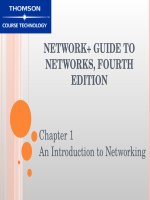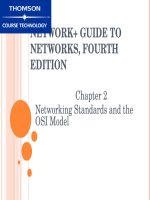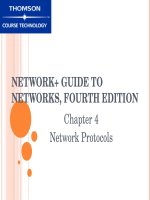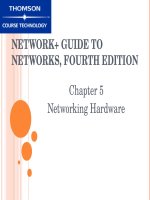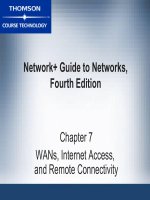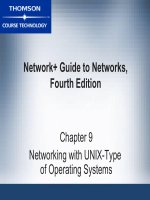Guide to network essentials 4th chapter 14
Bạn đang xem bản rút gọn của tài liệu. Xem và tải ngay bản đầy đủ của tài liệu tại đây (407.65 KB, 32 trang )
Chapter 14:
Understanding and
Using Internet
Resources
Learning Objectives
Discuss the Internet and its available
services
Access resources on the Internet and
understand its addressing methods
Discuss ways to establish an Internet
connection
Guide to Networking Essentials,
2
The Internet
The Internet evolved from the U.S. Department
of Defense’s Advanced Research Projects
Agency Network (ARPANET)
ARPANET used TCP/IP which became the data
communications protocol suite of the Internet
Focus of the Internet has shifted from sharing
information among universities and research
labs to commerce and communication
Guide to Networking Essentials,
3
The Network Administrator
and the Internet
Network administrators can use Internet for
variety of reasons:
To
gain information about computers and networks
As source for technical assistance
To download software upgrades, patches, and fixes
Guide to Networking Essentials,
4
What’s on the Internet?
Some of the most popular Internet services include:
Chat and instant messaging
Electronic mail (e-mail)
Peer-to-peer file sharing
File Transfer Protocol (FTP)
Newsgroups
Telnet
World Wide Web (WWW)
Remote Conferencing
Guide to Networking Essentials,
5
Chat and Instant Messaging
Real-time communication has appeal for
applications from virtual classrooms to support
groups
Many
Web sites offer chats with technical experts,
authors, and celebrities
Instant messaging applications let users
interact privately
Applications
include AOL Instant Messenger,
Microsoft Chat, ICQ, and IRC
Guide to Networking Essentials,
6
Preferred form of communication for individuals
and organizations
E-mail address consists of
username@domain name
On the Internet, Simple Mail Transfer Protocol
(SMTP) is upper layer protocol that supports email
Multipurpose Internet Mail Extensions (MIME)
is standard governing e-mail attachments
Guide to Networking Essentials,
7
Peer-to-Peer File Sharing
Share music, movies, and applications
Some services are pay services like Napster and
Apple’s iTunes
Free services include Kazaa, Blubster, and
LimeWire
Up
to individual to ensure files are legally sharable
Guide to Networking Essentials,
8
File Transfer Protocol Servers
File Transfer Protocol (FTP) is high-level
protocol for accessing or depositing files on
remote servers
Figure 14-1 shows WS_FTP Pro, a graphical
FTP utility
Many Internet browsers include support for FTP
file transfer
Figure 14-2 shows Microsoft’s FTP site
Guide to Networking Essentials,
9
WS_FTP Pro
Guide to Networking Essentials,
10
Microsoft’s FTP Site
Guide to Networking Essentials,
11
Newsgroups
Network News Transfer Protocol (NNTP)
handles distribution, inquiry, retrieval, and
posting of news articles
Over
80,000 public newsgroups available on Internet,
with USENET most popular one
May be unmoderated or monitored
Maintain posts for short period of time, called scroll
rate
Guide to Networking Essentials,
12
Newsgroups (continued)
Must have NNTP client to access newsgroup
Organized in a hierarchical structure,
alphabetically by category
Valuable source for news about viruses, system
bugs, new software, and tools
Can provide “peer-level” technical support
For listing of all available Internet newsgroups,
visit groups.google.com
Guide to Networking Essentials,
13
Telnet
Oldest TCP/IP-based service
Lets user run programs, execute commands,
and interact with remote system on Internet
or any TCP/IP-based network
Most modern operating systems include a Telnet
server
Windows
NT server must use third party product for
Telnet access
Guide to Networking Essentials,
14
World Wide Web
Internet and World Wide Web are not same
WWW is newest Internet service in this chapter
Web consists of millions of documents written in
Hypertext Markup Language (HTML)
Can browse using links
Primary protocol is Hypertext Transfer
Protocol (HTTP)
Front page of Web site is called home page
Guide to Networking Essentials,
15
World Wide Web (continued)
Use search engine, such as Yahoo! or Google,
to find Web sites with specific information
Most hardware and software vendors have Web
sites
Contain
product information, updated documentation,
new drivers
Web is rich and useful resource
Guide to Networking Essentials,
16
Remote Conferencing
Allows employees to telecommute
MS Messenger, CUSeeMe are common applications
Video and voice conferencing
Application sharing
Whiteboard discussions
Instant messaging
Does not always provide quality audio and video
Some applications combine traditional phone conferencing and
software for application sharing and whiteboard discussions
Guide to Networking Essentials,
17
Locating Internet Resources
Internet address lets users navigate Internet
Address usually represented as resource names
Name has corresponding TCP/IP numeric
address
Guide to Networking Essentials,
18
Internet Resource Names
Uniform Resource Locator (URL) is address
associated with Web-based Internet resource
Includes
protocol to use to access it
Protocol is followed by colon, such as HTTP:
Two forward slashes begin the address
Domain name identifies the organization and
references a server
Guide to Networking Essentials,
19
Domain Name System (DNS)
DNS protocol resolves symbolic names to
corresponding IP addresses
Example:
www.microsoft.com references IP address
207.46.250.252
Last element of domain name, called top-level
domain, categorizes type of organization
Other domain types may indicate country of
origin
Guide to Networking Essentials,
20
Common Domain Types
in the United States
.com
.edu
.gov
.mil
.net
.org
Commercial organizations or
businesses
Educational institutions
Government organizations
(except military)
Military organizations
Network service providers
Other organizations, usually
nonprofit
Guide to Networking Essentials,
21
Country-Specific Domains
.au
.fr
.uk
Australia
France
United Kingdom
For complete, geographically organized list
of country top-level domain names, visit
www.norid.no/domenenavnbaser/domreg.html
Guide to Networking Essentials,
22
Getting a Domain Name
Simple and affordable process
Usually
$35/year or less
Cost varied depending upon registrar and options
Numerous Web sites can register your domain name
for you
Select unused domain name and top-level name
May
also use new top-level domain .name to register
personal name or e-mail address
Guide to Networking Essentials,
23
Making an Internet Connection
Most users go through Internet Service Provider
(ISP) to connect to Internet
ISPs provide dial-up and dedicated links
Dial-up
lines using modems are most common
Other relatively inexpensive connections include Integrated
Services Digital Network (ISDN), cable modem, and
digital subscriber line (DSL)
Large companies and government bodies may
use higher bandwidth connections such as DS-3
or ATM
Guide to Networking Essentials,
24
Dial-Up Connections
Dial-up protocols include:
Point-to-Point
Protocol (PPP)
Serial Line Internet Protocol (SLIP)
CSLIP, a compressed version of SLIP
PPP is dial-up protocol of choice for ISPs today
because it supports these features:
Compression
Error-checking
Dynamic
IP addressing
Guide to Networking Essentials,
25

